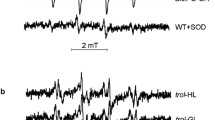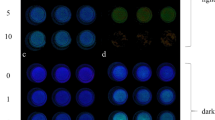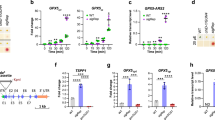Abstract
Singlet oxygen is reported to have the most potent damaging effect upon the photosynthetic machinery. Usually this reactive oxygen molecule acts in concert with other ROS types under stressful conditions. To understand the specific role of singlet oxygen we took advantage of the conditional flu mutant of Arabidopsis thaliana. In flu, the negative feedback loop is abolished, which blocks chlorophyll biosynthesis in the dark. Therefore high amounts of free protochlorophyllide accumulate during darkness. If flu gets subsequently illuminated, free protochlorophyllide acts as a photosensitiser leading almost exclusively to high amounts of 1O2. Analysing the thylakoid protein pattern by using 2D PAGE and subsequent MALDI-TOF analysis, we could show, in addition to previous described effects on photosystem II, that singlet oxygen has a massive impact on the thylakoid ATP synthase, especially on its γ subunit. Additionally, it could be shown that the activity of the ATP synthase is reduced upon singlet oxygen exposure and that the rate of non-photochemical quenching is affected in flu mutants exposed to 1O2.








Similar content being viewed by others
Abbreviations
- 2D PAGE:
-
Two-dimensional polyacrylamide gel electrophoresis
- ATP:
-
Adenosine triphosphate
- LUC:
-
Firefly luciferase
- MALDI-TOF:
-
Matrix-assisted laser desorption/ionisation time-of-flight
- NPQ:
-
Non-photochemical quenching
- 1O2 :
-
Singlet oxygen
- ROS:
-
Reactive oxygen species
References
Blokhina O, Virolainen E, Fagerstedt KV (2003) Antioxidants, oxidative damage and oxygen deprivation stress: a review. Ann Bot (Lond) 91 Spec No:179–194
Bosco CD, Lezhneva L, Biehl A, Leister D, Strotmann H, Wanner G, Meurer J (2004) Inactivation of the chloroplast ATP synthase gamma subunit results in high non-photochemical fluorescence quenching and altered nuclear gene expression in Arabidopsis thaliana. J Biol Chem 279:1060–1069
Charles SA, Halliwell B (1980) Effect of hydrogen peroxide on spinach (Spinacia oleracea) chloroplast fructose bisphosphatase. Biochem J 189:373–376
Foyer CH, Noctor G (1999) Leaves in the dark see the light. Science 284:599–601
Friso G, Giacomelli L, Ytterberg AJ, Peltier JB, Rudella A, Sun Q, Wijk KJ (2004) In-depth analysis of the thylakoid membrane proteome of Arabidopsis thaliana chloroplasts: new proteins, new functions, and a plastid proteome database. Plant Cell 16:478–499
Gorman AA, Rodgers MA (1992) Current perspectives of singlet oxygen detection in biological environments. J Photochem Photobiol B 14:159–176
Hideg E, Barta C, Kalai T, Vass I, Hideg K, Asada K (2002) Detection of singlet oxygen and superoxide with fluorescent sensors in leaves under stress by photoinhibition or UV radiation. Plant Cell Physiol 43:1154–1164
Hisabori T, Motohashi K, Kroth P, Strotmann H, Amano T (1998) The formation or the reduction of a disulfide bridge on the gamma subunit of chloroplast ATP synthase affects the inhibitory effect of the epsilon subunit. J Biol Chem 273:15901–15905
Jabs T (1999) Reactive oxygen intermediates as mediators of programmed cell death in plants and animals. Biochem Pharmacol 57:231–245
Kanazawa A, Kramer DM (2002) In vivo modulation of nonphotochemical exciton quenching (NPQ) by regulation of the chloroplast ATP synthase. Proc Natl Acad Sci USA 99:12789–12794
Keren N, Berg A, van Kan PJ, Levanon H, Ohad II (1997) Mechanism of photosystem II photoinactivation and D1 protein degradation at low light: the role of back electron flow. Proc Natl Acad Sci USA 94:1579–1584
Meskauskiene R, Apel K (2002) Interaction of FLU, a negative regulator of tetrapyrrole biosynthesis, with the glutamyl-tRNA reductase requires the tetratricopeptide repeat domain of FLU. FEBS Lett 532:27–30
Mittler R (2002) Oxidative stress, antioxidants and stress tolerance. Trends Plant Sci 7:405–410
Muller P, Li XP, Niyogi KK (2001) Non-photochemical quenching. A response to excess light energy. Plant Physiol 125:1558–1566
Murray J, Taylor SW, Zhang B, Ghosh SS, Capaldi RA (2003) Oxidative damage to mitochondrial complex I due to peroxynitrite: identification of reactive tyrosines by mass spectroscopy. J Biol Chem 278:37223–37230
Neuhoff V, Arold N, Taube D, Ehrhardt W (1988) Improved staining of proteins in polyacrylamide gels including isoelectric focusing gels with clear background at nanogram sensitivity using Coomassie Brilliant Blue G-250 and R-250. Electrophoresis 9:255–262
Niyogi KK (1999) Photoprotection revisited: genetic and molecular approaches. Annu Rev Plant Physiol Plant Mol Biol 50:333–359
op den Camp RG, Przybyla D, Ochsenbein C, Laloi C, Kim C, Danon A, Wagner D, Hideg E, Gobel C, Feussner I, Nater M, Apel K (2003) Rapid induction of distinct stress responses after the release of singlet oxygen in Arabidopsis. Plant Cell 15:2320–2332
Pascal AA, Liu Z, Broess K, van Oort B, van Amerongen H, Wang C, Horton P, Robert B, Chang W, Ruban A (2005) Molecular basis of photoprotection and control of photosynthetic light-harvesting. Nature 436:134–137
Roeder B, Naether D, Lewald T, Braune M, Nowak C, Freyer W (1990) Photophysical properties and photodynamic activity in vivo of some tetrapyrroles. Biophys Chem 35:303–312
Schmitt S, Glebe D, Alving K, Tolle TK, Linder M, Geyer H, Linder D, Peter-Katalinic J, Gerlich WH, Geyer R (1999) Analysis of the pre-S2 N- and O-linked glycans of the M surface protein from human hepatitis B virus. J Biol Chem 274:11945–11957
Schwede T, Kopp J, Guex N, Peitsch MC (2003) SWISS-MODEL: an automated protein homology-modeling server. Nucleic Acids Res 31:3381–3385
Smith PK, Krohn RI, Hermanson GT, Mallia AK, Gartner FH, Provenzano MD, Fujimoto EK, Goeke NM, Olson BJ, Klenk DC (1985) Measurement of protein using bicinchoninic acid. Anal Biochem 150:76–85
Sugiyama K, Hisabori T (2003) Conformational change of the chloroplast ATP synthase on the enzyme activation process detected by the trypsin sensitivity of the gamma subunit. Biochem Biophys Res Commun 301:311–316
Telfer A, Bishop SM, Phillips D, Barber J (1994) Isolated photosynthetic reaction center of photosystem II as a sensitizer for the formation of singlet oxygen. Detection and quantum yield determination using a chemical trapping technique. J Biol Chem 269:13244–13253
Trebst A (2003) Function of beta-carotene and tocopherol in photosystem II. Z Naturforsch [C] 58:609–620
Vener AV, Ohad I, Andersson B (1998) Protein phosphorylation and redox sensing in chloroplast thylakoids. Curr Opin Plant Biol 1:217–223
Acknowledgments
We would like to thank Klaus Apel (ETH Zurich, Switzerland) for providing the flu mutant, Jon Hughes (Justus-Liebig University, Giessen, Germany) for critical reading of the manuscript and many helpful discussions. We are gratefully indebted to Melanie Bingel and André Imboden for technical assistance. This work was supported by the Justus-Liebig University, Giessen and in parts by the Swiss National Science Foundation (K. Apel).
Author information
Authors and Affiliations
Corresponding author
Rights and permissions
About this article
Cite this article
Mahler, H., Wuennenberg, P., Linder, M. et al. Singlet oxygen affects the activity of the thylakoid ATP synthase and has a strong impact on its γ subunit. Planta 225, 1073–1083 (2007). https://doi.org/10.1007/s00425-006-0416-8
Received:
Accepted:
Published:
Issue Date:
DOI: https://doi.org/10.1007/s00425-006-0416-8




